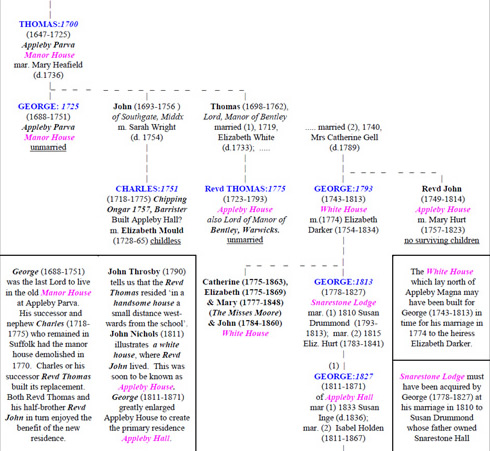Appleby History > In Focus > 13 - The Moores of Appleby Parva 2
Chapter 13
The Moores of Appleby Parva
Part 2 - The Heyday of the Moores at Appleby, 1751-1871
by Richard Dunmore
The death in 1751 of George Moore marked the beginning of a period of affluence and change. It was the heyday of the Moores at Appleby Parva. Although the direct line of the Moores as lords of the manor failed three times, new ideas in agriculture and ‘good’ marriages by some of the main holders of the lordship resulted in an accumulation of wealth, never to be achieved again. Indeed, later generations were to find difficulty in maintaining the three grand houses, built or acquired at this time, on the proceeds of an agricultural estate economy. A simplified lineage of the Moores through this period is shown below.
THE MOORES AND THEIR RESIDENCES AT OR NEAR APPLEBY PARVA
IN THE 18th & EARLY 19th CENTURIES
Lords of the Manor shown in CAPITALS with DATE of inheritance
Residences thus
Interruptions in the Direct Succession
By 1751 the Moores were well established in the upper levels of county society and George Moore had been High Sheriff of the County of Leicester in 1728. But he had not married, so there was no direct heir. The estate passed to his nephew Charles Moore, son of George’s younger brother John (probably a City merchant) who resided in Southgate, Middlesex (to follow the lineage please refer to the Table above). Southgate lies about 12 miles north of the City, near Barnet.
Charles Moore (1718-75) was a lawyer, living for a time at Chipping Ongar in Essex. Although Charles was almost certainly born in Middlesex, his father John (1693-1756) was born in Appleby. A Doctor of Law, Charles was a barrister practising at the Middle Temple, one of London’s Inns of Court.
There may have been a personal reason for Charles’ decision to live at Chipping Ongar. Chipping is about 25 miles NE from London, i.e. more than twice as far out as Southgate, and one third of the way towards Kentwell Hall in Suffolk. At Kentwell Hall lived his third cousin Elizabeth Mould (1728-65), the youngest daughter of John Moore. (John had inherited Sir John Moore’s fortune on the condition that he changed his name from Mould to Moore.) Charles and Elizabeth married in 1751, but they had no children (1). Charles died in 1775 at Long Melford, near Kentwell Hall, and was buried in the family vault at St Dunstan in the East in London, where Sir John Moore had been laid to rest.
The lordship next passed to Charles’ senior male cousin, Revd Thomas Moore (1723-1793), another bachelor. Revd Thomas had inherited from his father the lordship of the parish of Bentley near Atherstone in north Warwickshire, thus adding more capital wealth to the Appleby Parva lordship.
Revd Thomas in turn was succeeded by his half brother George Moore (1743-1813). At last the holder of Appleby Parva manor was married with a thriving male heir and, thereafter, the inheritance passed regularly father-to-son until the Appleby estate was finally sold in the early 20th century. George Moore occupied a prominent position in Leicestershire society, being High Sheriff in 1794 and one of the county deputy lieutenants (2). Moreover in 1774 George had ‘married well’, to Elizabeth Darker (1754-1834) the young heiress and daughter of William Darker of Barwell, whose wife was Elizabeth Milner of Seckington.
George’s son and heir, another George Moore (1778-1827), was also fortunate financially in his marriage, although personally it resulted in tragedy. His first wife, Susan Drummond (1793-1813), was daughter of John Drummond of Megginch Castle, Co. Perth and Snarestone Hall. Her mother was a daughter of the Earl of Westmoreland. Susan seems to have brought Snarestone Lodge into the Moores possession as dowry (3). She produced a son and heir, another George (1811-71), but died soon after the birth of her second child Susan Drummond Moore in 1813. George Moore married again, to Elizabeth Hurt, younger sister of Mary the wife of his uncle Revd. John Moore. Like his father, he was High Sheriff for Leicestershire, in 1821. The lordship of Bentley, in north Warwickshire, was still in the Moore’s possession and George inherited this with the Appleby lordship on the death of his father in 1813.
Parliamentary Enclosure
Charles Moore (1718-75) could have had no intention of living at Appleby Parva manor. This is apparent from the provision his uncle George made, in the final codicil to his will (1751), for three unmarried nieces to occupy a large part of the manor house (4). Charles, as the new owner, would draw income from the produce of the home farm and rents from the other estate farms, but would be an absentee landlord.
By the late 18th century land owners believed that the old open-field system of farming was inefficient and unprofitable. Although as many as 1200 acres of the parish had already been enclosed by private agreements, enclosing the remaining open land of the parish was the way to increase production and profit (5). As a lawyer, Charles Moore must have known how to achieve this and we must suspect that he was the prime mover in bringing the 1771 Appleby Enclosure Act to fruition. He was certainly one of the main beneficiaries (6).
Appleby House, precursor of Appleby Hall
Appleby Parva manor house was demolished in 1770 during Charles Moore’s period of lordship (7). Whether Charles, who died in 1775, intended to build himself a new house at Appleby Parva to replace the old manor is not clear. However, by 1790, his successor Revd. Thomas Moore (1723-93) was living in a handsome house a small distance westwards from the school (8). This is the presumed site of the demolished manor house and the location of the residence soon to be known as Appleby House and later as Appleby Hall. Whether it was Charles or the Revd Thomas who built the new house we cannot say. Revd Thomas had inherited from his father Thomas the manor of Bentley, situated south-west of Atherstone and adjacent to Merevale Hall, and was therefore wealthy in his own right. It is of course possible that he completed what his cousin had begun but he, clearly, was the first to enjoy the amenities of the new residence.
Revd Thomas died unmarried in 1793. By this time, his successor as lord of the manor, George Moore (1743-1813), was already settled with a growing family in another new house about a mile north of Appleby Magna (the White House - see below). Consequently, the new house at Appleby Parva was next occupied by George’s younger brother, Revd John Moore, and his wife.
Revd John Moore was one of many patrons of John Nichols’ History and Antiquities of Leicestershire. The volume which contains the accounts of Appleby Magna and Appleby Parva was published in 1811. Nichols described the two ‘white houses’, i.e. the residences of George and Revd John (2). He included clear descriptions of their locations so there is no doubt which is which. The first edition 1 inch OS map shows the two houses as Appleby Houseat Appleby Parva and White House north of the village (9). The 1832 Appleby Parish map refers to the Appleby Parva house as the Town House (10). The name Appleby Hall had clearly not yet been introduced.
Nichols illustrates his account with an engraving by James Basire of Revd John Moore’s white house in Little Appleby, i.e. Appleby House, based on a drawing by Joseph Hunt, the writing master at Appleby school (2). This is reproduced below. It may be dated approximately by the fact that Joseph Hunt was writing master from 1794 to 1802 (11). Also, local militia are seen exercising in the grounds of the hall, a symptom of the current war against revolutionary France, 1793-1802. Revd John’s brother and squire, George Moore (1743-1813), was Captain Commandant of the Appleby Volunteer Force (12) (13).
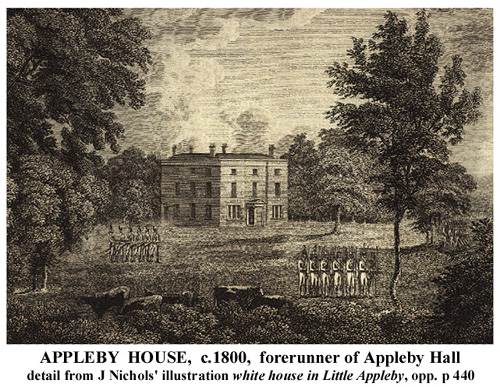
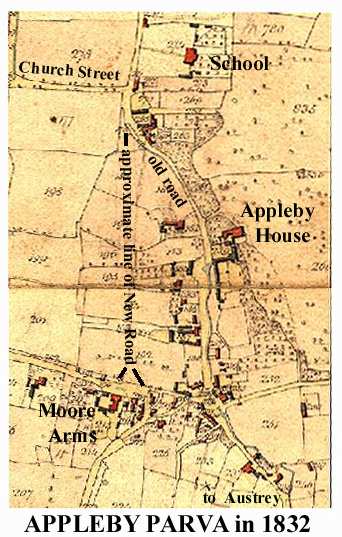
Revd John Moore (d.1814) and his wife Mary (d.1823), whose only child Mary Ann died in infancy in 1788, continued to live at Appleby House until their respective deaths. In 1796 major work costing £1861 was carried out to the house by Revd John Moore, using the Uttoxeter architect and builder Thomas Gardner (14). The illustration given by Nichols probably shows the house after these early alterations were made.
The next squire George Moore (1778-1827) lived at Snarestone Lodge (see below), both of the white houses being already occupied. His son and heir George Moore (1811-71) was born there. The younger George became lord of the manor of Appleby Parva on the death of his father (in 1827) by which time great-aunt Mary had died, leaving Appleby House vacant. George junior was therefore the next occupant, probably moving in after his marriage in 1833. Between 1832 and 1838, Appleby House was considerably enlarged and the surrounding grounds extended and landscaped (15) - see below. Perhaps to reflect its new grandeur the name seems to have been changed at this time to Appleby Hall. The Hall was now established as the main Moore residence.
The White House
George Moore (1743-1813), heir to his half-brother Revd Thomas, married the heiress Elizabeth Darker in 1774 and they lived at what became known as the White House approximately ¾ mile NE of Appleby church. Little information and no illustrations survive of this residence, apart from Nichols’ description: He[George Moore] resides in a white house, in a remarkably pleasant situation, nearly a mile North from the church .... The site is marked on all OS and other maps up to the present day, although the building has long since gone (16).
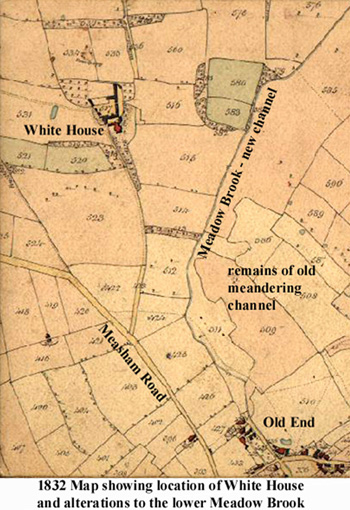
After George’s death in 1813, the White House continued to be occupied by his widow Elizabeth and their unmarried children. These were the three Misses Moore i.e. Catherine, Elizabeth and Mary together with their youngest surviving brother John. Supported by many servants (13 at the time of the 1841 census), these four siblings continued to live at the White House until their respective deaths: Mary in 1848, John 1860, Catherine 1863 and finally Elizabeth in 1869 (17) (18). The Misses Moore devoted themselves to charitable causes. Like their uncle (Revd) John and aunt Mary, they were particularly keen supporters of the parish church, which underwent restoration in the 1830s. In her last years, the widowed Mrs Mary Moore (d. 1823) had been concerned about the fabric of the church and she left £1000 in her will towards this (19).
It appears that after the death of Elizabeth, the house was abandoned and by the 1880s it had been pulled down. By this date the Appleby estate was in severe financial difficulties and was offered for sale (20). So the White House appears to have had a life of barely 100 years. Almost certainly built for George Moore and Elizabeth Darker in time for their marriage in 1774, it was their home and that of their unmarried children, the three Misses Moore and their youngest brother John, until the last of them died in 1869. Probably regarded as a burden on the struggling estate it was demolished before 1880.
Snarestone Lodge
The marriage in 1810 of George Moore (1778-1827) to Susan Drummond seems to have been the occasion of the acquisition of Snarestone Lodge for their marriage home. Susan was the daughter of John Drummond of Megginch Castle in Perthshire and Snarestone Hall.
Snarestone manor, later known as Snarestone Hall, was in the possession of the Charnell family from mediaeval times until the late 18th century (21). By 1800 the manor had come jointly into the hands of Colonel Samuel Madden, widower of Katherine Ryder , and Katherine’s sister Anne wife of Colonel Charles Powell Leslie. Katherine and Anne were daughters of Catherine, the last of the Charnells. By mutual agreement Colonel Leslie took the old manor house and Colonel Madden the neighbouring farm house which he enlarged to form Snarestone Lodge (22). Colonel Madden, a man of reckless living, is known to have sold up by 1802 (23). It would appear that John Drummond acquired both properties about this time and it seems likely that he gave Snarestone Lodge as Susan’s dowry.
Agricultural Innovation
As the owner of the large Appleby estate, which he inherited in 1813, George Moore was a pioneer in novel agricultural techniques especially those of drainage and irrigation. The large area of meadow land through which flowed the Meadow Brook below Appleby village must have lain saturated with water during the winter months and been prone to uncontrolled flooding (24).
Nichols tells us that George Moore ...was the first introducer of the improved system of watering grass-lands in this country. Mr Marshall, in his Agricultural Survey of the Midland Counties, says “Mr Moore of Appleby has executed considerable work of this kind, and in a judicious manner; cutting a fresh channel on one side of the site of the improvement for a rivulet which winded through its middle, in order to prevent its overflowing at an improper season, and converting the old channel (partially filled up) into a main float; an expedient which may be frequently practised with good effect”. Mr Moore obtained a gold medal, for under-draining land, from the Society of Arts in the year 1794 (25).
Examination of large scale maps of the meadow land between Old End and the Mease shows clearly the straightened line of the Meadow Brook and the field boundaries betray its previous meandering route; see for example the White House map above. The word float seems to mean a drainage channel, akin to the word fleet.
Grand Plans: Appleby Hall
George Moore’s son, another George Moore (born 17 September 1811), inherited the estate on the death of his father on 25 June 1827. Although he was so young, he seems to have quickly decided what he wanted to achieve with the estate and the village. We do not know what advice he may have taken before coming of age but by 1832 Knight and Mammatt, land surveyors of Ashby de la Zouch, had produced a detailed survey of the whole of Appleby parish (10). In 1838 another large scale map was produced using the same field numbers (15). The two maps reveal that in the intervening years many changes were made especially at Appleby Parva. In particular a large extension was added to Appleby House. This was effectively a new mansion in classical style - Appleby Hall - the old house being retained as an attachment at the rear.
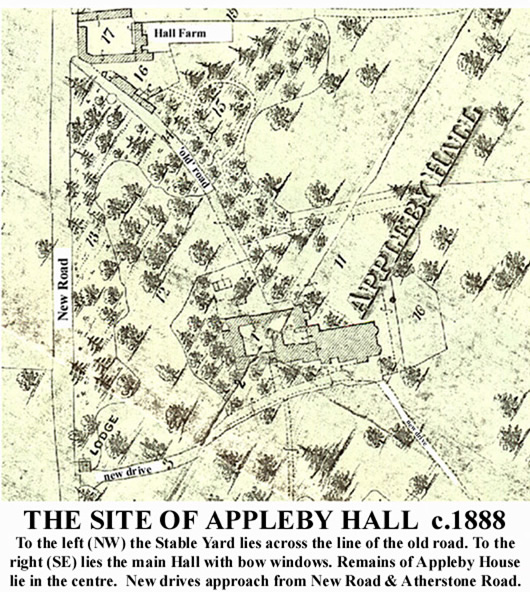
Appleby House lay south of, and close to, the road from Appleby Magna to Austrey (see 1832 map). With the aggrandisement of the house, the old road was replaced by ‘New Road’ with which we are familiar today. The new wing, with its imposing south-west entrance and south-east bow windows, extended into newly laid-out ornamental gardens; and the environs were made into a park. Stables and coach houses around a square stable yard, which Aubrey Moore remembered, were built across the line of the old road (14). New carriageways were built through the park to Atherstone Road and New Road where a gate-house was built; and the old road northwards from the Hall was retained as a service road from the stable yard to Hall Farm and the village (Appleby Magna). To facilitate these changes many adjacent farmhouses and buildings, shown west of the old road on the 1832 map, were demolished.
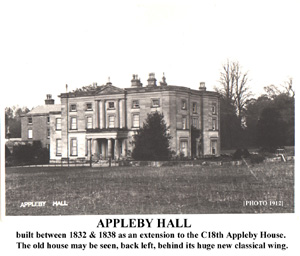
Click image of Hall for larger view
The stream which flowed from the West Hill past the old House was culverted from Appleby Parva to a point near the southern end of Church Street. Bricks from the demolished properties are said to have been used for the construction of this culvert (26).
Improvements were also made to the conditions of the squire’s tenants. Blocks of new houses were constructed in both Appleby Parva and Appleby Magna (Church Street, Top Street, Atherstone Road) re-housing people from sub-standard properties which were demolished. Following the 1835 Poor Law Act, the village workhouse on the Tamworth road was closed and the poor despatched to the workhouse at Ashby which had been enlarged to form a Union Workhouse for 100 persons in 1836 (27). Perhaps touched by the plight of some of the parishioners, the Misses Moore of the White House in 1839 built a block of five Almshouses opposite the Church. The Church itself underwent restoration and alteration following the initiative of Mrs John Moore. Truly the 1830s were a period of great change for the whole parish.
Notes and References
1. In the 17th and early 18th centuries, the family, although dispersed by the removal of members to London, the home counties, Suffolk and elsewhere, kept closely in touch, even to the point of inter-marriage. An earlier family link had been forged when Charles’ father John married: John and his bride Sarah were second cousins, Sarah’s mother Ruth being the daughter of George Moore (1629-84) of Appleby (Pedigree of Moore,College of Arms, 1770).
2. Nichols, op cit, p 440; the plate of Revd John Moore’s House at Appleby Parva is facing.
3. ‘Susan daughter of John Drummond of Megginch Castle Co. Perth & of Snarestone Hall Co. Leicester & Lady Susan his wife (daughter of John Fane ninth Earl of Westmoreland and the Lady Susan Gordon Daur. of Cosmo George ninth Duke of Gordon)’ - Pedigree of Moore,College of Arms, 1770
4. Will of George Moore, 3 Aug 1751, PRO: Ref. PROB II 604. The nieces are named in In Focus 12.
5. For calculation of the area of pre-Parliamentary enclosures see In Focus 9: Identifying Appleby’s Open Fields, part 1
6. Appleby Enclosure Act (1771) and Award (1772), Leicestershire Record Office 15D55/44; see also Nichols, IV, part 2, p 430-31
7. Nichols, op cit, p 431 (demolition of old manor house)
8. J Throsby, Excursions in Leicestershire, 1790
9. First Edition 1 inch OS Map, sheet 43, c1835, David Charles reprint 1970
10. Appleby Parish Map, 8inch (1832) with Reference (1831); it is suggested that Town House may be a contraction of Overtown House, The Overtown being a well-known alternative name for Appleby Parva.
11. R Dunmore, This Noble Foundation, 1992, p 138
12. Nichols op cit, p 440 (Appleby Volunteer Force)
13. Peter J Foss and Timothy Parry, in A Truly Honest Man, 1998, give details of the payments being made for setting up the local militia, e.g. p 44
14. Aubrey Moore, A Son of the Rectory, Alan Sutton 1982, pp 22-27; the author was clearly unaware of the more extensive changes made in the 1830s, evidenced by large scale maps.
15. Appleby Parish Map 24 inch, 1838. The field numbering is identical to 1832 map but no Reference exists. Large scale OS and other maps from the 1880s show the Hall and extensive grounds.
16. Nichols, op cit, p 440 If anyone is aware of any picture of the White House please let us know.
17. Dates of Burials are given in Appleby Parish Registers; the various Censuses, 1841, 1851 etc, show the surviving members of the household living at the White House
18. Hagar & Co Directory 1849 and F White’s Derbyshire Directory 1857 both list Elizabeth, Catherine and John Moore at the White House. White’s Leicestershire Directory 1877 has no mention of occupants of the White House, Moore or otherwise.
19. Eyre R J, The Nineteenth Century Restorations at St Michael and All Angels, Appleby Magna, TLAHS, LXI, 1987, p 44. Appleby Church restoration is also described with those of other Leicestershire Churches, 1825-50, by G K Brandwood in The Adaptation of Change, ed. D Williams, Leicestershire Museums, 1980, pp 35-57
20. The 6 inch OS Map (published 1887, surveyed 1881-82) and the Appleby Hall Sale Catalogue map (c.1888) both show that the White House was no longer standing, although farm buildings remained. This is in contrast with the 1832 Estate Map (see 10.) on which the house is clearly shown. No purchaser was found for the whole estate in 1888, but some outlying farms were sold at auction.
21. Snarestone Hall lay north of Snarestone Church across the road from Snarestone Lodge. Some of the building materials from the demolition of the hall appear to have been used in the construction of walls around Snarestone Lodge and Lodge Farm. I am indebted to Mrs Jane Davies of Lodge Farm for this information.
22. Nichols III pt 2, pp1045 and 1048* Nicholas Charnell who died in 1779 left the greater part of the lordship lands to three nieces: Elizabetha-Catharina, Alicia-Dorothea and Anna-Maria, the last of whom died in 1793 leaving her two elder sisters as co-heirs to the estate. Alicia-Dorothea appears to have died unmarried in 1794. Her sister Elizabetha-Catharina, who had married Revd. Charles Dudley Ryder son of the Archbishop of Tuam, died the following year leaving the manor to her two daughters Katherine and Anne. Katherine married Colonel Samuel Madden of Hilton Park, Co. Monaghan in Ireland and Anne married Colonel Charles Powell Leslie of Glafslough also in Co. Monaghan.
23. Colonel ‘Sam’ Madden was a ‘gambler and bon viveur’. These excesses culminated in a disastrous fire at Hilton in 1803, the ‘arrival of his creditors in 1812 and his expiry in 1814’ - Public Record Office of Northern Ireland web-site (The Madden Papers). According to PRONI, papers relating to Snarestone Hall are still held at Hilton, uncatalogued: ‘Also present is a ‘Reference book to the map of the Snarestone property’, 1778. Into this have been stuffed various plans, accounts etc. relating to Snareston and Swepston including a ‘Plan of the canal over Mr Farnell’s [sic - Charnell’s] estate at Snarestone’, paper marked 1794. [This volume is kept in the right-hand compartment of the large, glass-fronted bookcase in the study at Hilton and has not been deposited in or copied by PRONI].’
24. In Focus 9 and 10 (Open Field maps) show the location of the Big Meadow.
25. Nichols, op cit, p 440
26. Private Communication (villagers at ‘Old Appleby’ exhibitions) 1974, 1985. The end of the culvert may still be seen today behind the new white railings on the south side of Church Street near to where it meets Top Street and New Road.
27. K Hillier, The Book of Ashby de la Zouch, Barracuda Books, 1984
©Richard Dunmore, June 2002
Previous article < Appleby's History In Focus > Next article


